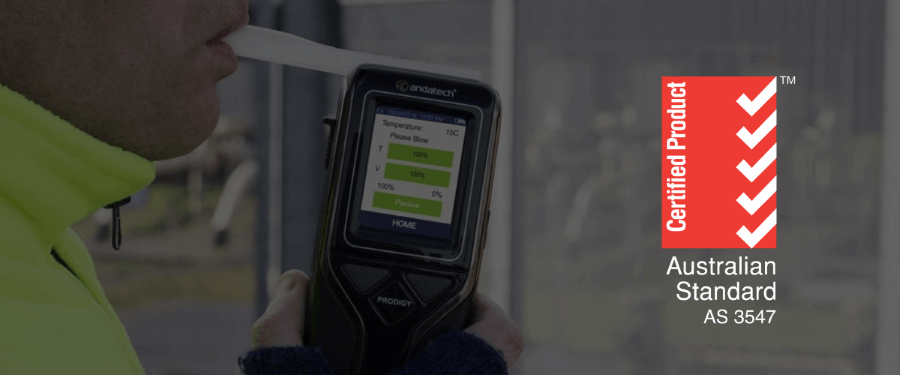Australian Standard AS3547 is published by Standards Australia, a non-governmental and not-for-profit organisation that develops and adopts internationally-aligned standards in Australia. The AS3547 specifies the requirements for different types of breathalysers used in this country in terms of:
- Product specifications
- Performance and accuracy
- Information provided alongside the breathalysers
- Calibration and testing requirements
Classification of breathalysers under Australian Standard AS3547
Under Australian Standard AS3547, breathalysers can be classified according to the four categories listed below, regardless of whether it is for personal use or industrial use. Each category has specific requirements unique to the nature of the breathalysers. At the same time, there are general requirements laid out in the Standard that all types of breathalysers should adhere to.
- Type 1 - Disposable single-use breathalysers
- Type 2 - Portable handheld breathalysers
- Type 3 - Wall mounted or fixed installed breathalysers
- Type 4 - Interlock devices for motor vehicles or machinery
Assurance on accuracy and good performance of your industrial breathalysers
While it is not mandatory for breathalysers sold in the market to be certified under the Australian Standard AS3547, breathalysers that hold this certification have proven reliability as they have undergone rigorous testing by a third-party laboratory and fulfilled the strict requirements specified in the Standard. This is especially important for breathalysers used on-site or in workplaces to ensure employees comply with alcohol and drug testing policies.
Based on the latest Australian Standard AS3547:2019 Breath Alcohol Testing Devices updated in June 2019, the latest criteria that breathalysers need to meet in order to be certified are listed below.
Accurate results
The breathalysers certified under AS3547:2019 should be able to detect breath alcohol levels down to 0.000g/210L in 3 decimal places when alcohol is not present in the exhaled air.
To ensure that the alcohol test results are as accurate as possible, Maximum Permissible Errors (MPEs) have been introduced to make sure that the readings do not exceed ±0.005g/210L for breath alcohol levels under 0.050g/210L. For a higher breath alcohol level, the reading displayed must not be 10% higher or lower than the actual breath alcohol level. For example, if the actual breath alcohol level of the exhaled air is 0.030g/210L, the displayed reading must be within the range of 0.025g/210L and 0.035/210L to be considered accurate.
This accuracy must be maintained over a minimum period of 6 months after each calibration so that the breathalysers are reliable for use in the long term.
Efficient usage
For frequent breath alcohol tests carried out at the workplace or on-site, it is important that subsequent breath alcohol tests can be done smoothly without long recovery times (i.e. the time required before the breathalyser is ready for the next test). The breathalyser should be able to take the next breath alcohol test within 1 minute after the previous test without being affected by the previous test. If the result of the previous test is greater than 0.100g/210L, the breathalyser is required to be ready for the next test within the next 3 minutes.
Stability of breath alcohol tests carried out in various conditions
Besides breath alcohol test under normal conditions, the breathalysers are tested under various physical and environmental conditions to ensure that their accuracy is not affected by the following factors:
- State of charge of the battery
- A wide range of temperature and humidity
- Electrical disturbances
- Shock and vibration
- Presence of interfering substances such as acetone, carbon monoxide, methane, and methanol
Reliable data
As it is crucial to keep accurate alcohol test data for each worker or employee, breathalysers certified under AS3547:2019 should be able to prevent the alteration and overwriting of previous breath alcohol test results. This ensures the legitimacy of the breath alcohol test data and prevents any fraud attempts.
The previous edition of Australian Standard AS3547:1997 certification remains valid
Even though the new Australian Standard AS3547:2019 came into effect in December 2020, the previous edition of Australian Standard AS3547:1997 remains valid. If your organisation does not have a legislated requirement to use only breathalysers certified with AS3547:2019, it is fine to continue using the existing breathalysers which are in compliance with AS3547:1997.
One of the most frequently asked questions about certification for breathalysers is whether a breathalyser with the latest certification is essential for on-site or workplace screening purposes. Australian Standard AS3547:2019 certification provides a high level of quality assurance for the breathalysers on accuracy and reliability in breath alcohol testing. It is recommended to go for breathalysers with AS3547:2019 certification and make sure that the breathalysers are calibrated regularly to maintain their peak performance for frequent and regular use.





